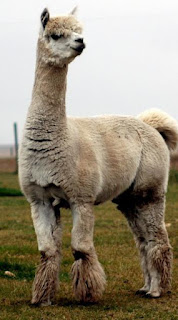Understanding Alpaca Talk
To fully understand your alpacas, you need to learn to lamaspeak. To do that, get yourself a glass of lemonade, and take a comfy lawn chair out where your alpacas are; sit down and observe as they interact with one another. Spend an hour or two a week watching your alpacas and soon you'll be an expert in their language. Below are are some of the sounds and actions you're likely to hear and see.
Alpaca Vocalizations
Although the Quecha and the Aymara refer to llamas and alpacas as "our silent brothers," lamas really aren't that silent. They have a wide array of vocalizations, which you will come to recognize as you get to know them. Here are a few to listen for:
Humming
Humming is a primary way alpacas express themselves. New owners often think lamas hum because they're happy or content, but that is generally not the case. Alpacas usually hum at various volumes and pitches when they're curious or feeling cautious, bored, lonely, worried, overheated, cold, in pain, frightened, or distressed. However, mothers do click and hum more peacefully to their new crias for the the first week or so and the cria often softly hums back.
Clucking and Snorting
Llamas and alpacas click to intimidate another lama, when telling another lama to "leave me along," or sometimes when they're simply worried or concerned. Females click when their babies wander too far away or if another mom or cria ventures too near. Lamas snort in response to the same stimuli, and clicks are sometimes interspersed with snorts.
Grumbling
Lamas grumble, a sound made deep in their throats, when issuing a fairly mild warning to other animals or when annoyed.
Alarm Calling
 When an alpaca perceives danger, it issues a distinctive call to alert the rest of the herd. The alarm call is a loud, undulating squeal or whistle. When you hear it, you'll recognize it. When lamas repeatedly scream an alarm call, investigate. Our guard dogs, no matter where they are on the farm will immediately look at the alpacas, see where they are looking and run in that direction. The Anatolian dogs will be in front, the llamas in a line about 30 feet behind them and then the alpacas in a circle with the babies in the middle within 5-7 seconds. It's impressive to watch.
When an alpaca perceives danger, it issues a distinctive call to alert the rest of the herd. The alarm call is a loud, undulating squeal or whistle. When you hear it, you'll recognize it. When lamas repeatedly scream an alarm call, investigate. Our guard dogs, no matter where they are on the farm will immediately look at the alpacas, see where they are looking and run in that direction. The Anatolian dogs will be in front, the llamas in a line about 30 feet behind them and then the alpacas in a circle with the babies in the middle within 5-7 seconds. It's impressive to watch.
Screaming
Lamas scream when they're truly angry - another sound you can't miss. Males scream when fighting one another and often neck wrestling or when warning another male away from their territory. Lamas, especially alpacas, also scream when they're deeply frightened or stressed.
Orgling
A male lama orgles when mating with a female. It's a unique, throaty sound that varies greatly from individual to individual, but it always indicates mating activity. When one male orgels, all of the other intact males in the area become increasingly aware of any females around them. Males orgle throughout the breeding process, from courtship throughout the final act sometimes for as long as an hour.
Body Language
Alpacas have a wide repertoire of body movements and stances that alert a savvy owner to what's going on. For instances, when a lama stands rigidly erect, ears prick forward, with tail raised, it is focusing on a distant scene or object of concern. Sometimes entire groups of lamas stand like then until one sounds the alarm.
Alpacas move their ears all around, back and forth. Unlike a horse, ears back does not necessarily mean they are mad or angry. When I hand feed our alpacas, the alpacas ears often go flat, listening for who is going to come up and push them off the food.
Spitting
There are several types of spit. Many times there is a dry air spit, warning someone else that they are not happy and stay away. A more commonly thought of, though much more rare spit, is the green spit. This is a serious spit and usually consists of bile, grass and hay. It certainly smells but luckily is very rare. In eight years, I have never been deliberately spit at. I have been spit on, but it was only because I was caught in the cross fire between two alpacas.
Using Alpaca Body Language
Once you understand how alpacas think, you can borrow their body language to suit your needs and speak back to them. For instance, many lama owners get results when they air spit back at spitty alpacas - just be sure you are the one with the last word / spit). If you choose to communicate with llamas or alpacas in lama body talk, you must not allow a pushy alpaca or llama to win.

